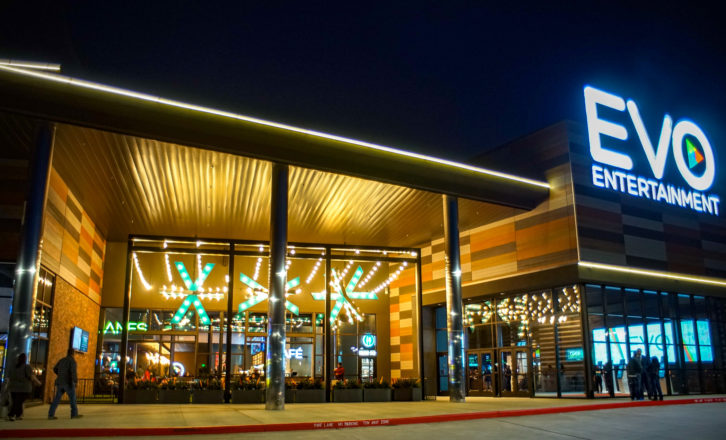
The EVO Entertainment Multiplex in Schertz, Texas was designed to immerse visitors in a wrap-around video environment with an incredible array of sources supporting entertainment including first-run movies, bowling, drinking, and dining. The EVO chain of entertainment venues, with eight Texas locations, is still welcoming guests with many COVID-safe adaptations; the AV-driven environment is upbeat even with occupancy limitations, demonstrating the benefits of a multi-media approach to guest experience. The company hired Mood Texas to come in and make it all happen. Andrew Adams and Eric Ramay are here to tell us how they got it up and running.
SVC: Andrew and Eric, we’ve got a huge project to talk about here. Before we get into the meat of that let’s hear some about Mood Texas. You’ve been around for a while and you get into some pretty hefty projects. So give us the lowdown.
Andrew: Sure. We’re a family-owned company, on our third generation now. Our president is the third generation. Started in 1954. Of course things were a little different back then as far as the AV field. We actually had reel-to-reel tapes transmitting music on towers and stuff like that, so the field has definitely changed since then. We are not a huge company. We have about 55 employees at any given moment. We basically cover the southern half of Texas. We also have a satellite office over in El Paso that covers a little bit into New Mexico.
How about describing the EVO Entertainment Multiplex for us in Schertz? This was a gigantic project. I think this place is something like 73,000 square feet?
Andrew: Yeah. It was a massive space and it’s basically a wonderland of fun as well as AV. They’ve got movies, arcade, bowling, a restaurant with a full bar. It’s one of those places you can bring the whole family to enjoy themselves, possibly drain their wallets. [Laughs]. They have several private event rooms that are still available for small parties. As far as AV goes there’s almost nowhere in the space that’s not filled with screens and speakers. We’ve got about 100 displays throughout the space not counting the movie theaters, two large video walls, one stretch video wall, an artistic video wall. And one of the coolest bar video setups I’ve ever seen and got to work with; this giant video wall above the bar that can turn into several video walls or one combined. So it was a dream project for sure.
Eric: Yeah. We got to not only design for the entertainment value, but the displays have a lot of branding on them as well. So lot of digital signage and items like that.
It’s an incredible space. You’re surrounded by video and sound everywhere you go.
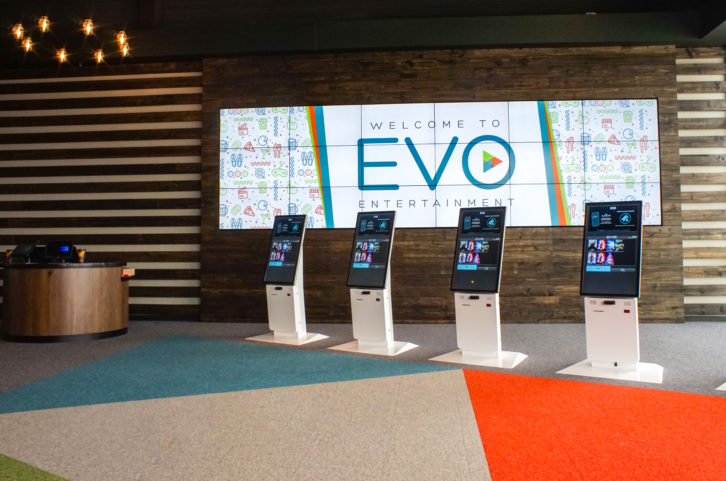 Eric: They want to keep people in there as long as they can. As long as they’re in there spending money that’s good for the owner, good for us, good for everybody.
Eric: They want to keep people in there as long as they can. As long as they’re in there spending money that’s good for the owner, good for us, good for everybody.
Andrew: And it’s a great way for us to show off Mood Texas. We’re all about creating unique experiences and as an affiliate of Mood Media we’re best known for our music service, our digital signage, our scent marketing. So this project allowed us to really show off those sensory solutions, especially with the digital signage on all of these displays and all of these massive video walls. So it was just an amazing show of our work as a whole. They even have a custom scent at EVO.
The real heart of this place as far as the technical part is the Just Add Power 3G Ultra HD over IP system. Why did you go with that particular platform?
Andrew: A few different reasons. Previous experience. We’ve had really good experience with the quality of product and the ease of use. We had to stay competitive in the pricing. The system has a decent price point and also it runs off standard Category cable, so we have CAT-6 running and transmitting signal. We didn’t have to go to CAT-6a shielded or anything like that. So the cost of the actual cabling infrastructure was way down compared to, let’s say, an HD-Base-T system with a higher-grade cable. And it would be capable of delivering instantaneous switching, which is very important to the video wall application, which we may talk about a little bit later. Then, of course, the expandability. So right now we’re adding to the system—it’s the simple fact of just putting some more receivers on the network switch and integrating them into the control. Insteaed of having to reinvent the wheel we’re just going right into a standard switch. So that’s just an awesome feature.
I would think that one of the more time-consuming parts of the installation might have been running a lot of cable.
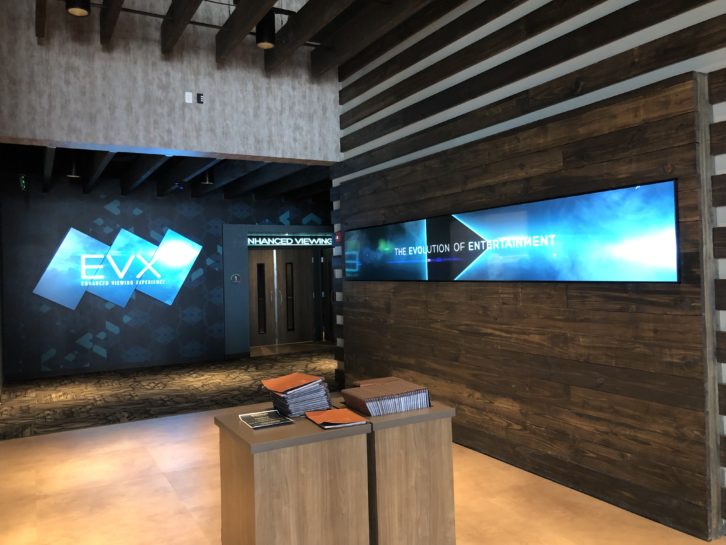 Eric: Yeah. That was a decision I made during the design process. They already had a contractor doing all their network cabling. We did some cabling but we actually had them run all the cable because they were already running their wireless interface. All the networking was done by them so it just made sense to pull in the same exact cable for us; why are we going to be tripping over each other? So it made us a lot more efficient and it made our price point look great because we were combining the labor that they already had.
Eric: Yeah. That was a decision I made during the design process. They already had a contractor doing all their network cabling. We did some cabling but we actually had them run all the cable because they were already running their wireless interface. All the networking was done by them so it just made sense to pull in the same exact cable for us; why are we going to be tripping over each other? So it made us a lot more efficient and it made our price point look great because we were combining the labor that they already had.
Let’s talk about that big video wall. I believe it’s in the bar area. How did you set that up? I know there are a number of different configurations that are easily selectable.
Andrew: There’s actually two huge video walls. One of them is at the entrance. That’s a 3×6 with eighteen 55-inch screens. It’s just basically a welcome screen. It’s got full screen 4K graphics on it all the time. So we were able to utilize the internal processing of the NEC displays to have a single media player feeding into a single HDMI input and the screens themselves create the wall. So it’s a very, very simple but dramatic experience as you walk in. The other video wall is above the bar. That’s a 2×9 and that one is configured completely differently using Just Add Power receivers at each display. It allows us to combine screens in any format we like. EVO really likes to do four 2x2s all right next to each other. It allows them to do the single display showing a single source. And then Eric programmed commands so that at one push of a button the entire 2×9 becomes one graphic just showing cool EVO stuff. That can be set on a timer or on a command. So it’s a really impressive visual experience as you walk up to that bar. That’s one of my favorite parts of this project.
Eric: And just to add to the bar video wall, we used Just Add Power and integrated into those receivers the ability to create video walls and pick out different quadrants of a certain image. So on the programming side, on the RTI side, it took a lot of pain and suffering but we were able to get it to where it’s as simple as hitting a picture of the video wall layout you want. For the background, I was able to write macros where it looks at what the current sources and picks the correct quadrants. It will just simply switch and completely reconfigure that video wall. It’s that simple from the user interface. Hitting one picture fires off the list of commands longer than my arm.
What about the creative part of this and how people are going to operate it?
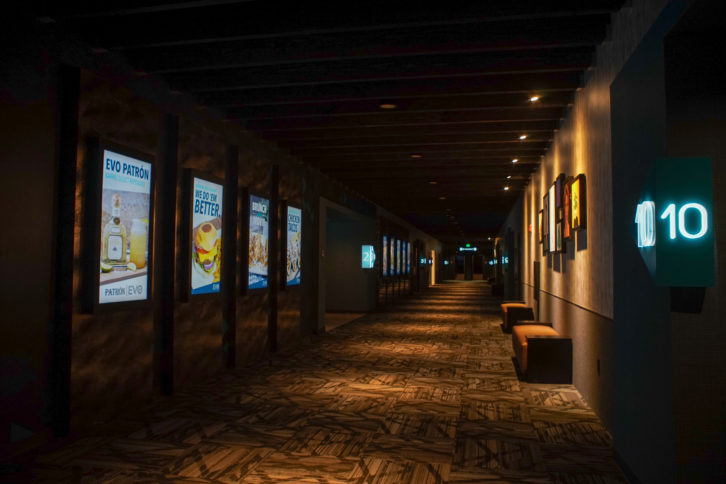 Eric: Well, it was a lot of fun. Like I said it took a little bit of bashing but once we got the final product we were able to see that everything was dancing in one concert with a simple-to-use interface and all these different mechanics. Like I said, projectors, screens, on-and-off, all those kinds of things, audio levels, all that was just simple to use. It all made sense. All levels were easy to recall and save. Every time I walk in there I’m just proud of our whole team and how we’re able to get that all to work. I’m so happy that Mitch and the EVO team continue to work with us. So it’s not just us that had a great experience, it’s our customer, which is really important to us.
Eric: Well, it was a lot of fun. Like I said it took a little bit of bashing but once we got the final product we were able to see that everything was dancing in one concert with a simple-to-use interface and all these different mechanics. Like I said, projectors, screens, on-and-off, all those kinds of things, audio levels, all that was just simple to use. It all made sense. All levels were easy to recall and save. Every time I walk in there I’m just proud of our whole team and how we’re able to get that all to work. I’m so happy that Mitch and the EVO team continue to work with us. So it’s not just us that had a great experience, it’s our customer, which is really important to us.
Was the building construction still going on while you were in there or was all that done and the place open for the AV stuff to go in?
Andrew: It was pretty much done, but just like anything they were finalizing stuff and we were just part of the multiple different crews doing the final tack-ons. We had the networking team in there when they were moving in the games for the game area. So by the time we were finishing up we were right there with everybody else putting on the final coats of paint, the final walkthrough by the general contractor, all that kind of stuff. So all the way from pre-wire to that point, we were right there walking out when everybody else did.
Eric: As far as timing, we got in really early. Mitch showed me renderings of the project before they had even broke ground so we had almost a full year to think carefully about every piece of this project, how it was going to work together, and bring the visions of the owner as well as our expertise together into something magical and impressive—something like no one’s ever seen in a space like this. So it was really great that we were able to get in really early on the design phase because once we got to installation it was go, go, go. They were on time. I think it was a three-month installation window they gave us. They were racing a competitor who was opening right down the street. EVO won the race and all the vendors, including us, were racing at that point. We were really glad that we had every single detail figured out before we even got to running the first cable. And you mentioned the fun of the experience. Part of that, once again, was dealing with the owner, Mitch, sitting down with him and going through his vision and then coming up with a way to exceed his vision and make sure it all worked the way he saw things. We would all brainstorm what would make this space a great experience and then we would be able to come up with a solution.
This system is very complex but it’s got to be easy to operate so how did you set up control for the whole building?
Andrew: We have two different screens that are mirror images of each other. They’re 1-inch displays. They’re made by RTI. They’re POE so they just run back to our switch and then they’re able to have commands over the entire system including video routing, audio controls, audio presets, room combining, separating all from six different pages. So we try and condense it down so they didn’t have to go through a novel of different commands. We have a mobile iPad on a magnetic charger they can pull off the wall and walk around the entire space instead of being static and trying to hope that everything is happening. They can walk around the space and basically control the whole system right at their fingertips.
Oh, that’s got to be great especially for the various sound environments.
Andrew: Yeah. Instead of just hoping that volume is good you can walk over there, you can see the people’s reaction. If they start grabbing their ears you went a little too high. If it’s a really great song you can play it any way. You can make a lot of decisions with that mobile iPad and they do. It’s a great feature.
So where is all the support gear located? Was there a whole floor dedicated for that?
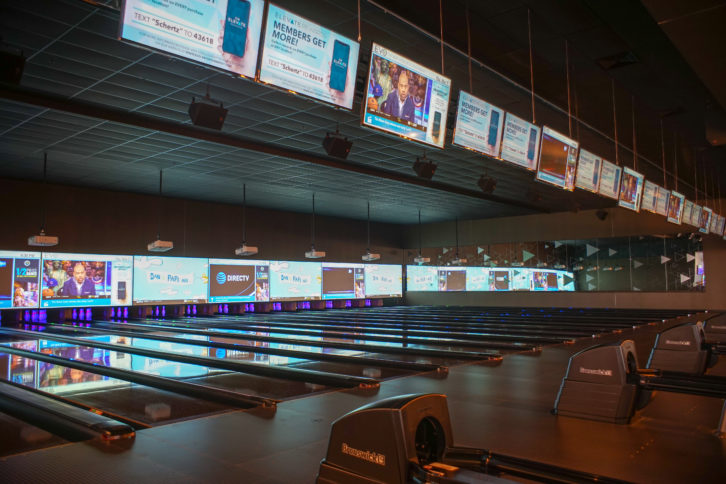 Andrew: Well, not a whole floor. So on the second floor of the theater is where all the projectors are and there are a multiple racks up there that take care of the internal theater sound systems, which we didn’t do. So they have multiple racks up there. There are networking racks, security racks, theater racks basically, and then of course the projectors that are actually shining through the glass on the displays. We’re just part of the whole scape up there. We simply had two Middle Atlantic racks – and that’s another thing great about using standard network switches with Just Add Power. We didn’t have to have a huge system. We have two racks that are highly organized. I think by the end of it there were over 300 cables that were interspaced throughout the whole place, neatly organized onto that rack.
Andrew: Well, not a whole floor. So on the second floor of the theater is where all the projectors are and there are a multiple racks up there that take care of the internal theater sound systems, which we didn’t do. So they have multiple racks up there. There are networking racks, security racks, theater racks basically, and then of course the projectors that are actually shining through the glass on the displays. We’re just part of the whole scape up there. We simply had two Middle Atlantic racks – and that’s another thing great about using standard network switches with Just Add Power. We didn’t have to have a huge system. We have two racks that are highly organized. I think by the end of it there were over 300 cables that were interspaced throughout the whole place, neatly organized onto that rack.
How is that whole system automated?
Andrew: The system is automated by using the RTI processors. So after discussions with management we are able to not only automate volume throughout the day but we also let change what those automated volumes are at a whim. So let’s say we have it go to a certain dB in the morning, they can actually say that’s not loud enough. They can resave that. Or when a fire alarm goes off all the screens go down. There are a lot of different things that happen when the fire alarm goes off and then has to restart immediately if it’s just a false alarm or if it’s a test. Then day and night on and off, all the projectors, all the screens, everything comes on at a certain time. Nobody even has to hit anything. The screen actually tells them it’s down and everything else comes on, the speakers and the outside TVs. It just simply happens.
In addition to the movie theaters and meeting spaces they’ve also got a huge bowling alley. There are a bunch of projectors in there so how do you use the projectors?
Andrew: The bowling alley is a really unique space. The projectors at the existing EVO locations were really not impressive and it sort of took away from the experience. So we wanted to make sure and get this right at the new location. Our distributor, Almo, actually sent us a few different NEC models and we were able to show Mitch the drastic difference between what they had before and what they could have at this location, and pick which model he thought looked best. The model he picked was an NEC 6500 lumen laser projector. We have eight of those pointed at 850 3-1/2-inch Draper fixed screens and they are seamless image-to-image. They are bright. I mean, they almost look like LED panels on the end of the lanes. Really impressive image, and each one of those has a Just Add Power receiver connected to it as a distribution source. Then we have another eight displays right above you next to the bowling scoring screens showing mostly digital signage. Those are also using Just Add Power receivers with the same distribution.
 Eric: Yeah, and once again the NEC projectors are seamlessly put in there with the Just Add Power, so they’re sharing all the sources with all the other displays including the video wall above the bar. They have access to all those sources – DVD player, satellite receivers – everything that everybody else has. Full on and off, all automated. They didn’t want somebody to have to go out there with a remote, walk down the lane and try to hit the IR bug. So the screens come on at a certain time every morning and they shut off at a certain time at night. It makes efficient use of the projectors. And we also monitor the bulb life and everything like that to where we can actually fire off warnings as they get close to the end of life on those projectors, or if there’s anything going on.
Eric: Yeah, and once again the NEC projectors are seamlessly put in there with the Just Add Power, so they’re sharing all the sources with all the other displays including the video wall above the bar. They have access to all those sources – DVD player, satellite receivers – everything that everybody else has. Full on and off, all automated. They didn’t want somebody to have to go out there with a remote, walk down the lane and try to hit the IR bug. So the screens come on at a certain time every morning and they shut off at a certain time at night. It makes efficient use of the projectors. And we also monitor the bulb life and everything like that to where we can actually fire off warnings as they get close to the end of life on those projectors, or if there’s anything going on.
It would seem quite a bit safer to have the passive screens down there where there are bowling pins flying around than some very expensive electronic video displays.
Eric: Exactly. And sometimes they’re working down there and they can bump into those screens. I mean, we actually had one that somebody accidentally really bumped into but it was a simple matter of making sure it was level again. And the way the screens butt up, as Andrew brought up, it looks like one continuous display. It’s very clean looking. The width of those bezels on those screens is very thin; you just a very clean look on the end of those bowling lanes.
A lot is going on in there sound-wise. It’s a very noisy environment. I noticed there are some speakers extended down from the ceiling.
Andrew: Yeah. We went with those because they’re very directional. The reason we went that route is the sound is emanating from the lane coming back at the people bowling. We decided to do that so the experience is the same when you’re going up and approaching the lane. It will give you that full-force audio as you’re bowling instead of having just speakers above the people who are watching. They wanted a full immersive experience— the music being part of it. That included the Klipsch KI-262 speakers, facing them for the mids and highs. And then we of course had the 15-inch subwoofers for every four lanes. That’s covering some really deep lows. Once again that’s all adjustable to how deep they want the bass to go.
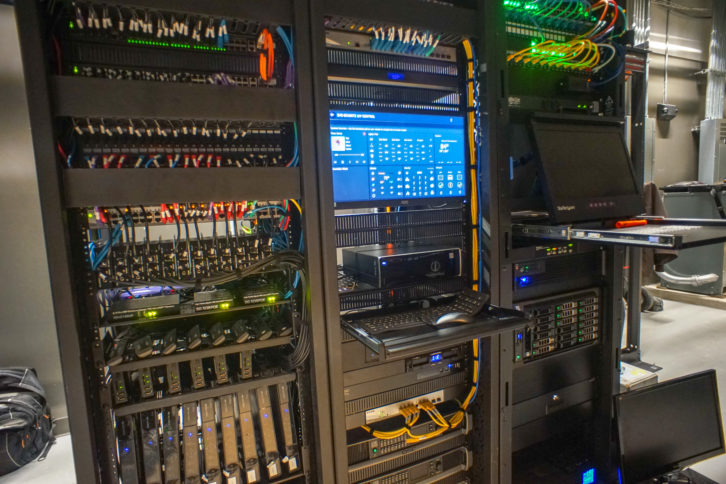 In an environment like this it seems the trickiest part of it would be the sound, just keeping it isolated and localized.
In an environment like this it seems the trickiest part of it would be the sound, just keeping it isolated and localized.
Andrew: Right. And overcoming all of the difference in sound from an empty bowling lane to a full one is drastic. I mean, it’s a loud activity with people talking, yelling and then the pins and the balls themselves. So that bowling lane has the ability to get really loud and have some really high-quality audio. You could have a rager of a party in there.
Eric: And all that is all easily controlled and it’s all limited and everything to where yeah, they can get it loud enough to hurt your eardrums but they can never blow up those speakers. The control automation puts in the limits to keep them within a certain range so we don’t get a call out there saying we have to replace multiple speakers. It keeps them to where they stay honest with the sound.
That long line of projectors coming down from the ceiling looks pretty cool. How do you get the video distributed to those projectors?
Andrew: It’s the same system that we used for the video wall in the bar, the same one for the displays everywhere. There are Just Add Power receivers at each of those projectors. It’s full 4K on that unit and once again it just shows whatever source they want and it’s easily addressable from a control pad. They can send any source to anywhere. Any display that has a Just Add Power device on it, they can send any of their sources to any of those displays. That’s the same for the NEC projectors.
And if you want to take a break from the action you can go out on the patio.. I think there are some Sunbright 75-inch monitors out there. How was it setting those up and doing sound for that area?
Andrew: It was fun for that one because we have the displays out there, and once again we had the Just Add Power system, so it was fairly simple to hang the displays out there. But the cool thing was with the sound. They wanted people to be able to hear sound as they are walking up, but we also have the challenge to not make it so the people sitting on the patio were completely awash in it, holding their ears. So what we came up with was array speakers up high—the JBL CBT 1000s—so we can send constant dB audio far out in the parking lot while still retaining a manageable level in the patio. Once again, from the control they can either send the music source out there, they can send their own auxiliary source out there, or they can actually just play whatever is on the display. So if they have a football game out there, they have this great speaker blasting audio for the football game right out there on the patio. It’s a great experience to step out there and watch a game.
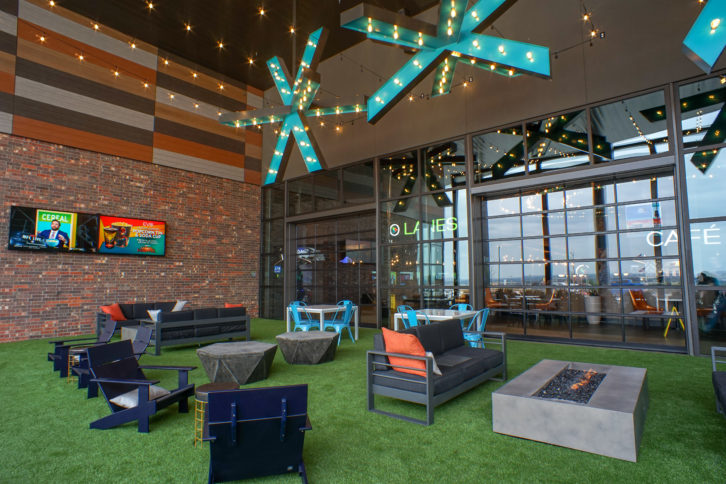 Eric: Yeah, we’ve got about a 70-foot throw of even coverage from that one speaker. It’s pretty incredible.
Eric: Yeah, we’ve got about a 70-foot throw of even coverage from that one speaker. It’s pretty incredible.
That’s really great that you don’t have to put up with a lot of signal format conversions or anything like that.
Andrew: No, no, no. It’s very intuitive. And simplicity was key here and that’s what we have.
Not only do you have bowling and all that action but there are also some event rooms. What’s in there for sound and video? I think you have the KX3 touch panels and those rooms can actually be combined into one bigger space.
Andrew: Yes. Exactly. So there are KX3 touch panels in each of the event rooms and from those panels you can control that individual event room, send your own source to the TV in that room only, play your own audio source in that room only. Or you can use those touch panels or the master iPad to combine the rooms to become one space, choose one dedicated source to play on all the screens in there or any combination you want. Overhead we have Klipsch IC-650 ceiling speakers. We used the Attero Tech POE Bluetooth and 3-1/2 millimeter audio input. It’s been a really nice setup; we worked directly with the event coordinator, who is not AV savvy at all, and she’s able to set up all of her groups in any sort of format she wants. And because the system is expandable, they actually added a new event room and were able to add some Just Add Power receivers, add the Attero Tech Bluetooth input, and voila, we have another event room.
Yes, whenever they want to expand you can expand.
Eric: Yeah, and that’s just it. That’s one reason we decided everything was going to be standard network infrastructure—no real specialty cable for most of it. We do have some different cable to run the speakers off of, of course, but we’re not reinventing the wheel or getting real expensive cable out there. We’re doing standard Category cable for all those units.
So this place had to open on time. What was your timeline on this project? Did you happen upon anything that proved to be a little more of a challenge than you expected?
Andrew: Yes. I’d say the biggest challenge was the fact that most construction companies in this field tell you when they’re going to open and that’s usually a figment of their imagination. But this one was dead on their schedule. So they had crews working overnight, they had crews working during the day. I’ve been in this business for 15 years. I’ve never seen a place this big get built this fast. So we had to be really on top of our game interfacing with the general contractor, interfacing with the owner, and making sure that we were on the right timeline. Sometimes that timeline just took us by surprise because usually we would look at it and our experience would tell us that we’ve got about a month, but then they’d come back and tell us we’ve got a week and that’s what would happen. It would be done. A big part of that was because they were racing a competitor that was probably about a half a mile away with a lot of the same systems.
That’s a huge number of people and different trades to coordinate. That’s got to be a big challenge not getting anybody too far behind or too far ahead.
Eric: Yeah. I’ve dealt with a lot of different construction projects and I’ve got to tell you, this one was like one big family. Everybody, even though we’re on top of each other during certain points, we got to know a lot of them very personally; there are still people I email to this day working around the country. Working with the owner Robert Mitchell and his family, everybody felt like part of the family during this whole process. It was actually, I have to say, the greatest experience I’ve had working on a construction site ever. Instead of having discussions that would turn into arguments, they were completely forthcoming, understood everything, and made sure that all our needs were met. And we tried our best to make sure all their needs were met. So it was a great experience.
I think you’ve said that it had to be designed to be operated by teenagers.
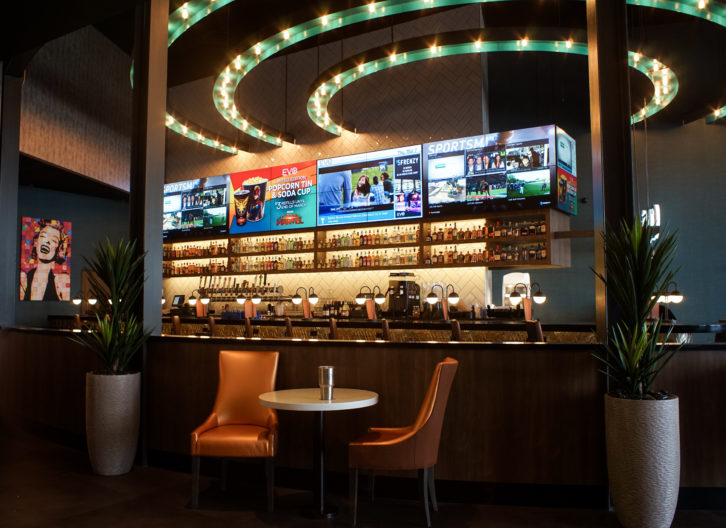 Andrew: Yes. We realized when we were designing this control system that the people using it were going to be very young; often teenagers. Think of the people that work at movie theaters. And they’re curious. They want to play with the system. They want to change things. So we had to make it bulletproof. We had to make it so they couldn’t screw it up. They had to have all the functions make sense and be cohesive so that they could just scroll through and do everything they need to do. We also put in some backup so that if something did go wrong they could call us and we could remotely reset the system at any time. We were a little worried about the end user on this really complex system. It’s worked out really well and a lot of times I show up and they do all the controls right there in front of me. I don’t even have to help. So I think we did a good job of allowing teenagers to operate this massive system.
Andrew: Yes. We realized when we were designing this control system that the people using it were going to be very young; often teenagers. Think of the people that work at movie theaters. And they’re curious. They want to play with the system. They want to change things. So we had to make it bulletproof. We had to make it so they couldn’t screw it up. They had to have all the functions make sense and be cohesive so that they could just scroll through and do everything they need to do. We also put in some backup so that if something did go wrong they could call us and we could remotely reset the system at any time. We were a little worried about the end user on this really complex system. It’s worked out really well and a lot of times I show up and they do all the controls right there in front of me. I don’t even have to help. So I think we did a good job of allowing teenagers to operate this massive system.
Eric: And Andrew put up a good point. Part of this, too, is we can log in anywhere in the world using the RTI platform. We can fire off different commands just to see what’s happening or we can bring everything back. One time I got a call and their screens weren’t on the right input. Somebody was just flustered and I was able to log in, hit one button and put everything back to what their standard layout is. Very simple, very easy to use, and also gives us the ability to make sure our customer is taken care of on the service side. We hit a button and they’re literally on the phone with us like ‘oh, okay. That’s working. We’re good.’
So what does Mood Texas have coming up?
Eric: Well right now we’re continuing with the EVO family. They like the system, they like working with us, they have other facilities with older equipment and we’re looking forward to bringing those facilities up to the same standard that this is. We’re working with the same people. It’s going to be different this time because we’re going to be working on places that are already open and we’re going to not be doing the whole place from the ground up. But this still gives us the excitement of being able to carry over those controls and carry over a lot of the systems into the newer facilities. We also just recently got done with a lot of stuff for Frost Bank, one of the biggest, well-known banks here in Texas, doing conference room systems. They have three conference rooms that were divisible and full VoIP integration so that was a really fun project. It’s a brand-new building in downtown San Antonio, beautiful building. It’s one of the highlights of the skyline of San Antonio now.
Well, this one was huge. I’m amazed when I see all of the images and think about getting all of this done on time. Great hearing the story on it. Good luck and thanks for talking with us about it.
Eric: Thank you for having us.
Andrew: Thank you again, Bennett.










